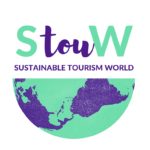Sustainable tourism in Nicaragua a decade of challenges and success stories - 2018
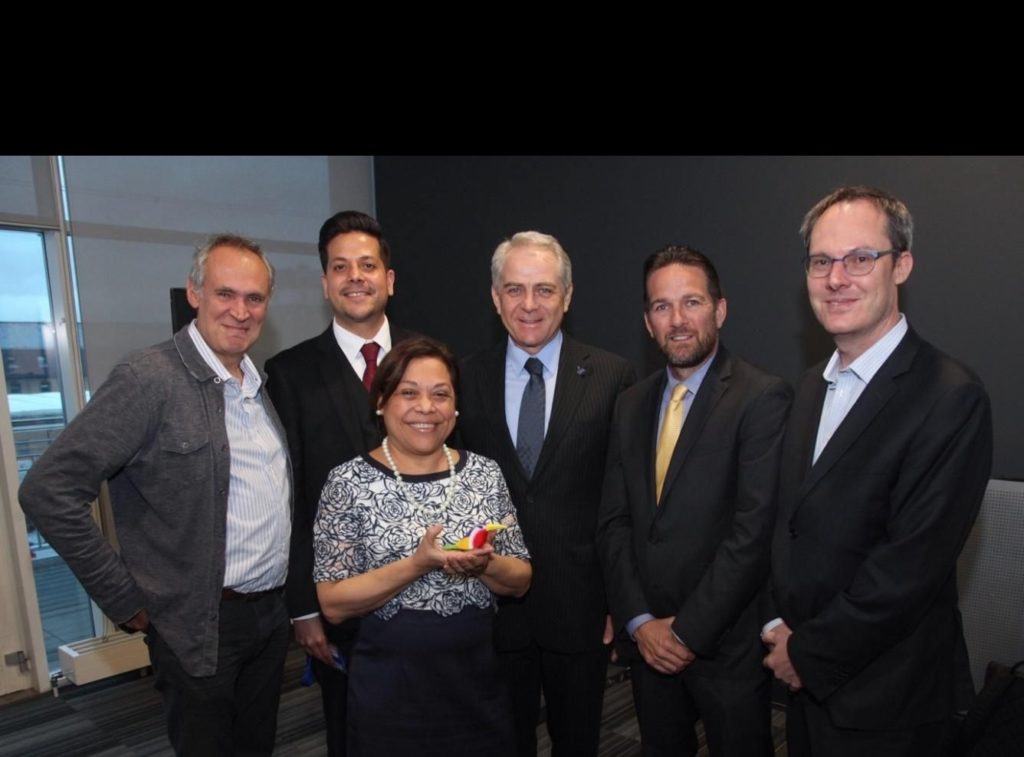
Often I have colleagues and students asking for practical examples and practices of sustainable tourism, Nicaragua was awarded the Sustainable and Responsible Tourism Destination of 2017 in the U.K. by LATA. During World Travel Market in London I attended the presentation of this interesting and beautiful country explaining it efforts to become a sustainable tourism destination.
Her Excellency Guisell Morales-Echaverry, The Ambassador of Nicaragua,introduced a presentation by four of the country’s private tour companies. Ricardo Carioni, Head of Country Promotion, outlined Nicaragua’s collaboration with a public programme for sustainable tourism, which has resulted in a significant increase in the number of sustainable travellers over recent years
Four Tour Operators in Nicaragua – Careli Tours, Solentiname Tours, Vapues Tours, Detour Travel recounted their personal journeys to sustainability. Their experience is in my opinion very relevant and positive that I wanted to share it as good examples of sustainable tourism practice and development for destination.
All four companies are members of TOPS (Tour Operators Promoting Sustainability) in Nicaragua. The organisation was founded in 2012 as a Rainforest Alliance initiative, with a mission to promote green activities and CSR actions both environmentally and socially. There are currently 6 members: Careli Tours, Solentiname Tours, Vapues Tours, Detour Travel, Oro Travel & Nicaragua’s Best Guides .
The organisation help develop good practices and train professionals involved in tour operation: guides, transport contractors, local community leaders and providers of food, handicraft, guiding, lodging and suppliers. It also represents the country internationally presenting tour operators best practices and sustainability success stories to a global audience.
Careli Tours created in 2007 the Eco-Schools project, together with Hotel Plaza Colón y Fondo Natura, an annual environmental and educational program. Since the program started, they have managed to provide environmental education to 2,500 children with an impact on 10,000 people. Axel Melchior, General Manager.

Jan Jorg Strik CEO & Founder, Vapues Tours pioneered taking groups of travellers to live alongside rural communities in Nicaragua. “Rather than being traditional tourists, they can participate in the community´s daily activities, which in turn allow them to experience the real Nicaragua. The travellers report that what they get out these trips is a unique and unforgettable life experience.” Vapues presents an annual “Sustainability Education” program with staff, providers and clients, as well as the immediate community.
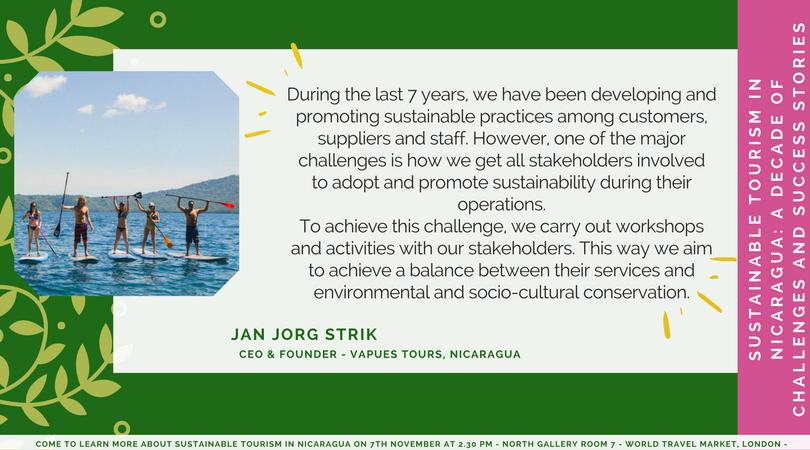
Immanuel Zerger, CEO & Founder, Solentiname Tours – Discover Nicaragua created the “Nicaragua Tourism Map – Traveling Sustainably“ featuring protected areas, private natural reserves, sustainable accommodation and 29 “Points of Life”. Each “Point of Life” offers participation in tourism development to cooperatives, artisans and local families; often socially excluded, with low income and single mothers.

Laurent Richardier, CEO & Founder of Detour Viajes, is creating on-going training programs with local communities on issues such as waste management, climate change, customer service or biodiversity conservation. “The goal is to have community-based tourism suppliers aligned with the sustainability values of our company, but also to train them in terms of market access so that they can reach potential clients by themselves, without having to depend on third parties,” added Laurent.
The training program started with a pilot group of only 3 communities, but it is being replicated across the country, hoping to involve a total of 14 community-based tourism projects in the near future. This initiative is fully funded by Detour Viajes, with help of the community projects that support the costs related to accommodation and food.
The Wonderful experiences of a not adventurous traveler: Esteros De Ibera - 2016
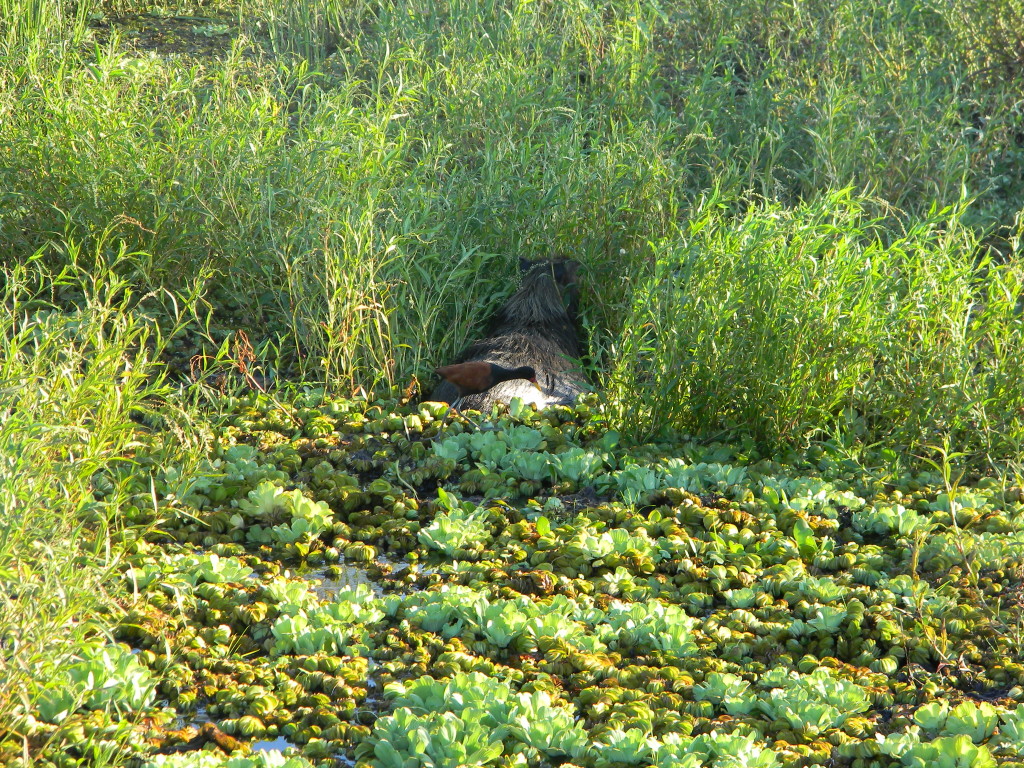
Second stop in my adventure in Argentina was up north in the middle of nowhere, well in the middle of Esteros de Iberà, in Colonia Carlos Pellegrini a town of 683 inhabitants. Esteros de Ibera is a wetland, actually is the second wetland of Latin America, the first one is the Pantanal in Brazil. I had very relaxing time at Ecoposada del Esteros, the place where I understood I am not an adventurous traveler, at all.
Susana, Florie, Ale and I left Buenos Aires during the night, thanking advantage of the night bus service to do the long distance we had to cover.
Welcome to the Ecoposada del Estero with Ale, Florie (hopineo) & Susana (viajero responsable). Thanks hopineo for allow me to use this photo!
Ecoposada is a wonderful place where you can relax, you can do activities discovering the surroundings, all the activities are included in the fee and that’s why in this wonderful place I also started to reflect about which activities I wanted to do and which not.
The fee includes every meal, stay and a very incredible environment where to relax. Incredible because it is not only beautiful but nature is everywhere, animals are free to come and go. When we arrived, for example, the first things I have seen were a couple of horses eating near the pool,that was amazing for me because I am from a beautiful area, but very urbanized. The meetings with their horses was just the beginning.

After recovering from the long trip (9 hours by night bus from Buenos Aires, plus 4 hours by daily transfer – bus again- from Mercedes) and when the sun was less burning, the group was ready to do the first activity: visit to the interpretation center of the Iberá Natural Reserve and the black howler Monks Path ( Sendero Monos Carayas).
Almost at the end of the path we saw a couple of them, beautiful monks: a cub, a female and after a while a male, checking if everything was ok for his family. It was a huge emotion, they were the first monks I have ever seen in my life and they were free! Only after a while I realised there were caimans sleeping under the sun, not far from our car ( in my opinion, it is never far 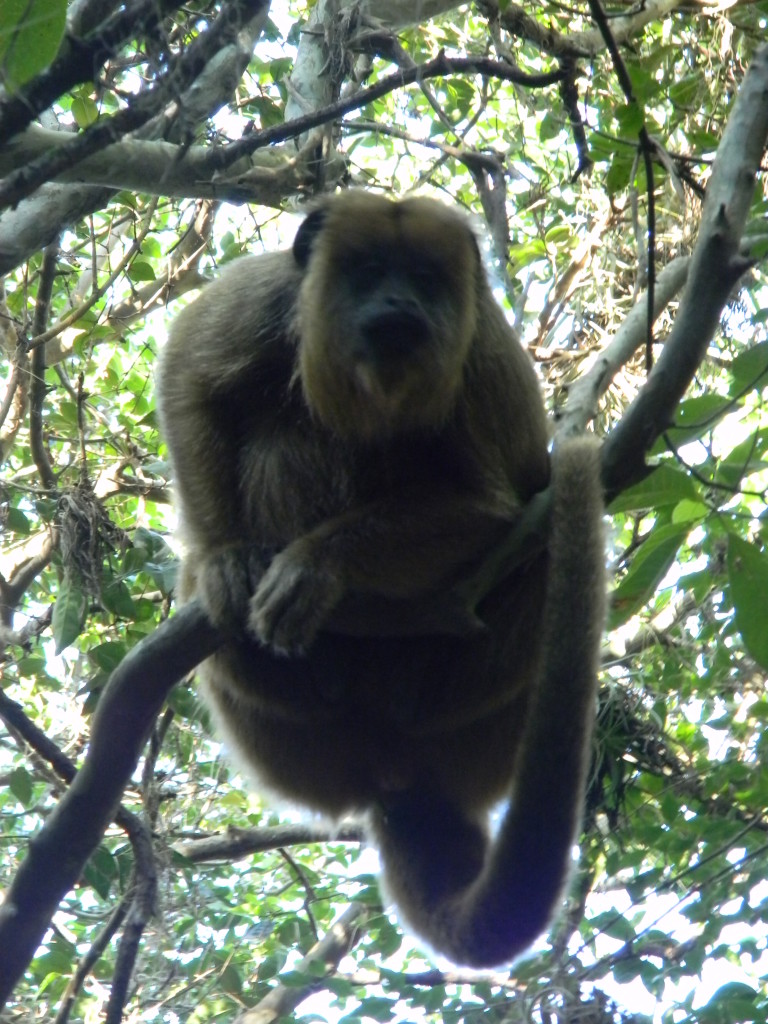 away enough from caimans). They are strong and wild animals I respect, but I am happy not to meet everyday.
away enough from caimans). They are strong and wild animals I respect, but I am happy not to meet everyday.
The visit continued with a walk along the wooden walkway leading to beautiful corners of the lagoon where a family of capybara was peacefully swimming. Our guide was Alberto, he speaks only few words in English but between our knowledge of Spanish and his understand of Italian we made it very well. Alberto is very knowledgeable, amusing and ironic, with a scared person like me made a lots of jokes regarding caimans especially.
Second day started with a visit to the ranch, it was a unique occasion we had because that day the gauchos had to castrate some of the steers, that happens only once a year. It was interesting to visit the ranch, but I did not appreciate so much the castration. I decided to stay far a way from the place where the animals were stopped, to see it from a good distance. The farm is property of Andrea’s family, she was very patient with me, she introduced us to her mother and offered us shadows and fresh water. I realised how hard can be life in this beautiful but very rural places and I felt so happy I have the opportunity to chose this life, if I want to but I able to live a different life. That morning I though a lot about equality, opportunities and life choices, thinking about the other side of agricultural jobs in Italy, where many immigrants are currently working, not always in good conditions.
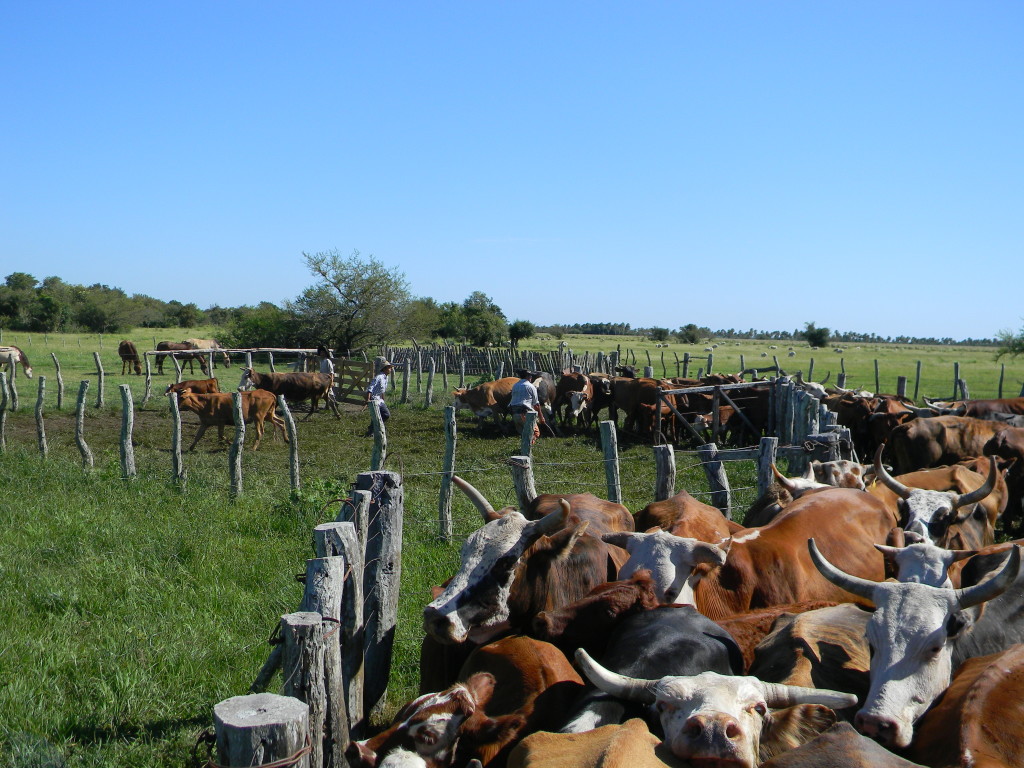
The great thing of Ecoposada activities organisation is we had time everyday to relax, reflect, write notes or just to sleep while we had everyday something interesting to do, always with amazing local guides: Andrea and Alberto. Around 5 pm we were ready to go, boat tour with Alberto, looking for caimans! I can barely find words to describe the beauty of the lagoon, even in Italian is very difficult. We have seen lots of plants & birds, it was a great emotion! Florie took photos and shoot for hopineo, I am sharing the video she made and a couple of funny photos with my new favourite animal (joking!)
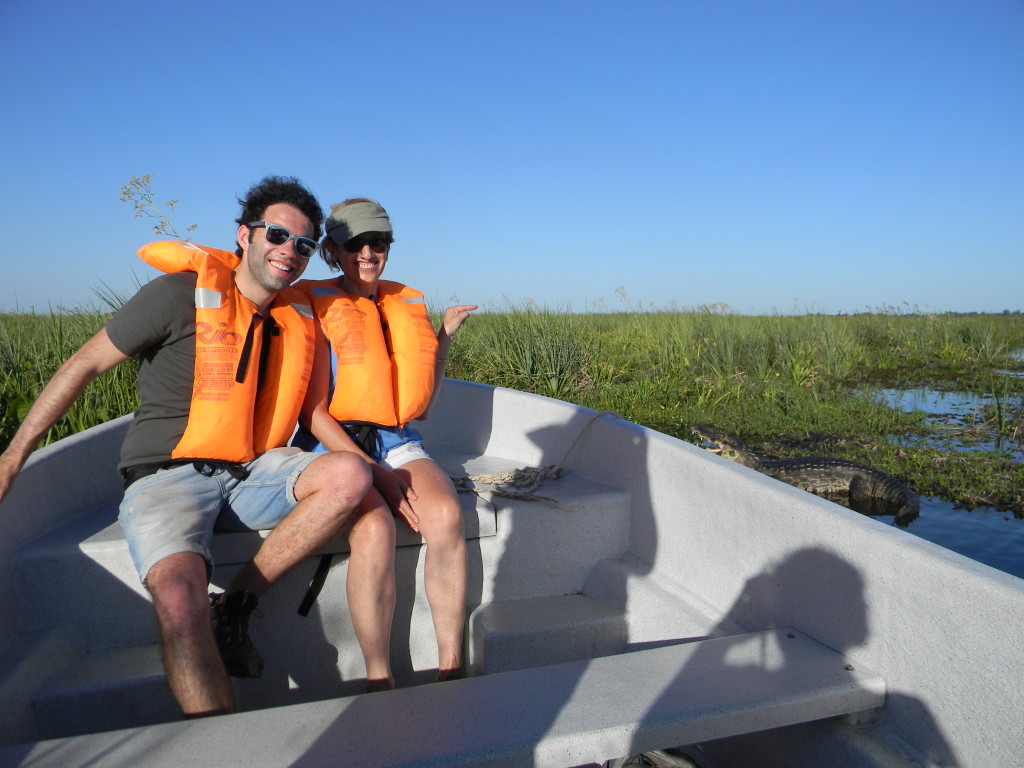
Video by Hopineo.org
The third day was all about kayak and horse reading, I avoided the kayak, I was so nervous even thinking about it, in the evening I tried to approach the horse I was suppose to ride, but I was so scared, nervous and I felt also stupid I couldn’t make it. I ended up taking a relaxing bath waiting my friends to come back.
I know I missed 2 opportunities that day, but we are not all the same, some people likes adventure & challenges, but I am not that kind of person. Ride an horse without self confidence can make you in trouble, like do kayaking surrounded by caimans, it is just not for anyone, not for me at least.
That doesn’t mean I didn’t enjoy the rest of the activities, only I know I have same limits that I don’t feel like to cross.
What about you instead? Are you an adventure lover?
I’d love to know about you and your scariest travel experiences!
Discover Ecoposada
The Wonderful experiences of a not adventurous traveler: Buenos Aires! 2016

I am glad to share with you a bit more of myself. I have to tell you a secret: I am not an adventurous traveler at all!!
I am scared of many things some understandable, some others, a bit silly, such as riding horses, rowing among caimans, touching snakes, speaking in front of many people, being in the riffled ocean on a regular touristic boat and others. But anyway I love to travel, I love to visit places and to speak with people informing me about their culture, traditions, problems and dreams.
During my last holidays in Argentina I reflected a lot about that, I am sure I am not the only scaredy cat around, not the only traveler, nor blogger. I hope sharing my thoughts and experience to inspire those of you stuck in your place believing that only adventurous people can have wonderful time and experience of the world. This is SO WRONG!
Listen to me, it is possible to travel the world, even to live in a different country and to fully experience a place even if you don’t like to risk your life or to simply exit your comfort zone.
First time in Latin America, Argentina, not only an holiday but an experience, with many positive aspect and a few negative too.
Why Argentina? Because I always dreamed about it, about the tango, the meat, the passion of this huge, huge country. A great factor was having a friend there, based in Buenos Aires my colleague Susana Sandoval, tourism services professor, responsible tourism professional and passionate communication developer.
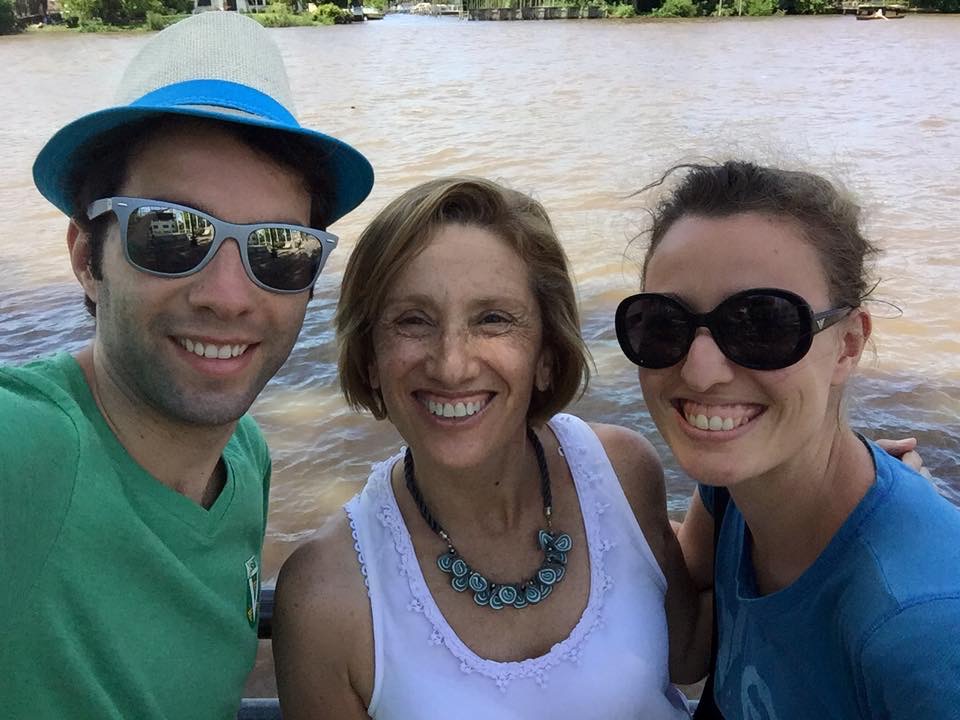
This was the first time I did not plan the details of the trip (neither the one to Brisbane, but I was going to work there, so it is a bit different), I just had a quick look at the guide, accepted a couple of Susana proposal and Ale (my partner) and I bought the flight ticket. We wanted it to be a very slow and relaxed holiday and it was especially at ecoposada del Esteros, but Buenos Aires was a different story.
Here is where we have been:
– Buenos Aires (5 nights)
– Colonia Carlos Pellegrini – Esteros del iberá (3 nights)
– Port Iguazu (3 nights)
– Salta, (2 nights)
– Cordoba (2 nights)
– Buenos Aires (1 night)
Buenos Aires is huge! I couldn’t believe it. It takes a while to get used to this city, to visit the most important places I have been walking for more than 60 hours in 4 days!! I visited Recoleta area, the Casa Rosada, the Congreso (a building similar to the unites states congress), the Colon Theatre, the Minicentro, the ecological reserve Costanera Sur, El Caminito at the Boca, and to start see it from the residents eyes I had to wait to go out with Susi. Regarding the food I have to say I will remember forever the lunch at tupe, never tested a more delicious meat!
Susana not only hosted me, she also suggested a couple of very interesting place to visit and activities to do, to better understand the porteños (residents of Buenos Aires). We visited El Tigre together, a beautiful town located in the estuary of Parana river where the residents of Buenos Aires go during the summer’s holidays and week end . Susi also joined us for the Graffiti tour in Palermo neighborhood, we discovered that the most of graffiti in this area are made to make the city more coloured and pleasant!

Susi also organised a meeting with Florie Thielin of Hopineo & Hervé Landetcheverry founder of Mater Sustentable travel Agency. Was great to find like minded colleagues and share a drink and vision with them. Florie has joined us also to the following destination: Ecoposada del Esteros.
I had very pleasant time in Buenos Aires, even if the social disparity of the city cannot be hided. I also get lost and visited the port area, a very poor area located close to the center (Retiro bus and train station) and the national Jorge Newbery Airport. Ones I came back from this place I was told it is the same of the Brazilian’s favelas.
A part from monuments and tours what really made my time in Buenos Aires was to finally visit Susana and meeting with residents and travelers.

Tips: take your time to get used to Argentina, in particular to Buenos Aires, it is a huge, relaxed country that needs you to be relaxed to enjoy it. The distances in Argentina are so long that to move between places you need 10 or more hours by car/bus, or a couple hours flight. Last, but not least learn some Spanish, it will be very useful! Everything was ok because I am Italian, that is similar to Spanish and because I know a bit of Spanish too, but a part from few times the people didn’t know English.
Sustainable Tourism World presents Narwell Ecotours Agency in Ecuador - 2016
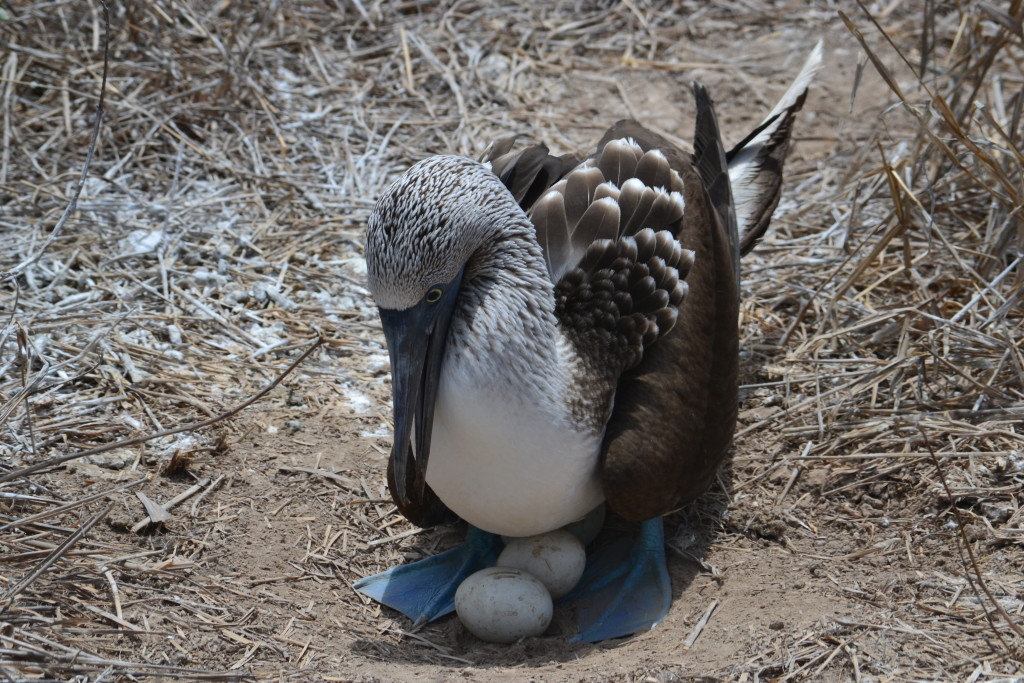
I am glad to introduce you Elsa Cuny and her Narwell Ecotours, a very special tours agency based in Ecuador. Time to let speak Elsa now, enjoy the reading!
Since I am a little girl, I have been passionate about Latin America. My dream was to live there, and it came true. I first traveled twice to Colombia, a wonderful country, for which I have a special emotional relation as my best friend is Colombian and we know each other since we are 3 years old. Then I went to Ecuador for an internship in Quito, and I decided to stay because I felt in love with the country, its natural and cultural diversity. So I have created my agency in 2011, Narwell Ecotours, in the region of Manabí. My life is ruled by sustainability, by values that we can find in sustainable tourism, and I saw a great potential for the development of this kind of tourism here.
Ecuador is 4 worlds: Amazon, Highlands, Pacific Coast and Galápagos. It is the country that has the biggest concentration of diversity in the world and I wanted to participate to the sustainable development of the unique region that is not well known. The Pacific Coast is only known for a little part of its treasures: the beaches, the sun, and the humpback whales, while all the intern side is mostly unknown, even if it has such a great cultural and natural diversity.
My goal is to show the real wealth of the region, how the people live, to make travelers discover authentic places and share unique experiences with the local communities. This is what will profit sustainably to the economy of the region.
I have implemented tours like the coffee road, the gastronomy and handcraft road, the Panama hat road, among others, and my favorite one: the cocoa road.

During this specific tour, we visit Don Alfonso cocoa plantation, which is a model for the Cocoa Fino de Aroma growing, one of the best cocoa in world. He explains us how the cocoa plant grows, what it needs to produce a great cocoa, and he also makes us taste exotic fruits he has in his plantation: oranges, coconuts, and depending on the season mango, guanabana, mamey.
Of course we taste also the cocoa bean, so delicious, trust me!
Then, we have lunch in a ranch where they produce handcraft beer (on Saturday and Sunday) or if it is during the week we stop in a different place. In both cases, we have the opportunity to eat the typical meals of the countryside. After that, we go to visit the regional cocoa producers association. There are now around 1 000 producers who sell their cocoa to this association. We learn about the process of fermentation, drying and then exporting or making chocolate. Of course we try chocolate!
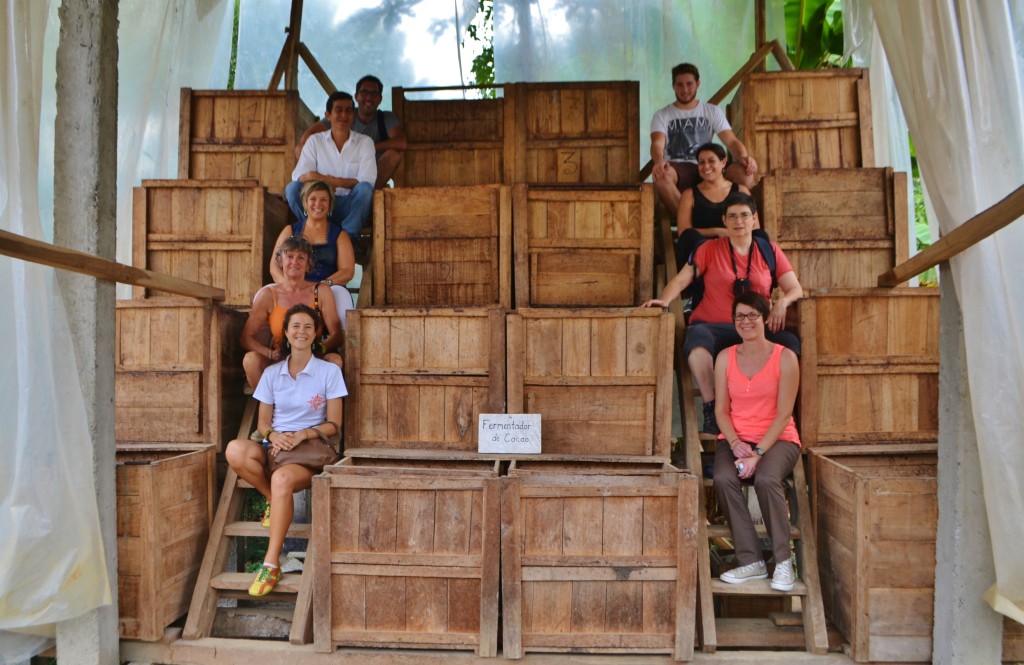
On our way back to Manta, we stop at Rocafuerte, where we taste the typical sweets of this town.
This tour can be of one day and we also adapt it for professionals or just chocolate lovers, up to 5 days. Each day you have another unique experience and you learn more, with different communities.
Everybody loves this tour, and this is the best reward for me: making discover the authentic life of Manabí, giving benefits to the local people, and obtaining the satisfaction of Narwell travelers. We offer you a unique experience, and you participate to the sustainable development of the region.
Costa Rica’s Communities - 2015
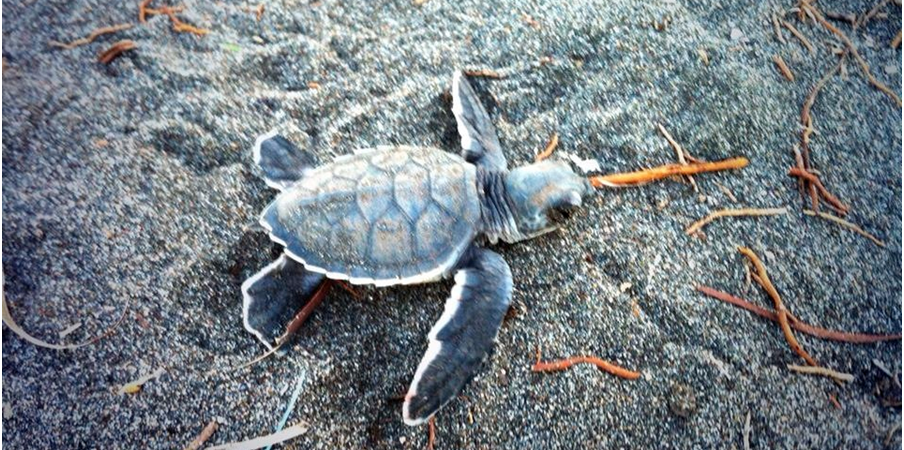
A Close Up on Costa Rica’s Communities – sustainable development.
The tourism industry economically influences many communities in Costa Rica; this is the case of Tortuguero and San Francisco, located on the northern Caribbean coast inside Tortuguero National Park. The area has several attractions, including a sea turtle conservatory, various tours, sport fishing, and Tortuguero National Park, which was established in 1975 and is one of the oldest national parks in Costa Rica. Tortuguero National Park attracts “50,000 tourists annually to see nesting turtles and visit the tropical rainforests” (Tortuguero Experts). Tourists visiting the park pay a $10 entrance fee. Sea turtle tourism is the region’s most important economic activity. The canals also attract thousands of visitors, and tourism continues to grow along with the construction of hotels and other businesses.

On the other hand, San Francisco is a smaller community whose establishment was influenced by the tourist attractions in Tortuguero. “San Francisco was founded in 1989 as a small land squatter community” (Van Oudenhoven, 2007). People are attracted to the village of San Francisco for work, “People are lured by the area’s growing tourism industry and its promise of fixed jobs” (Van Oudenhoven, 2007). Most of the businesses in San Francisco are hotels and restaurants, and there are a few ‘pulpers’ or general stores as Tortuguero’s tourism industry continues to grow, as will the community of San Francisco.
Tortuguero is an example of a community that switched its economy from the extraction of natural resources, sea turtles, to the protection, conservation, and education of sea turtles. After the National Park was established, laws were enforced, deeming “the taking of turtle meat or eggs is illegal and punishable by jail time” (Campbell, 2007). Today, the communities take pride in their natural resources and are the only Costa Rica region with no cars. However, there is an existing plan to build a road from La Pavona to Tortuguero. This road is unnecessary and will be detrimental not only to the tourist-based economy but also to the environment and social aspects of the communities. I conducted a research study and interviewed local businesses to find their perceptions on the construction of this highway. The results showed businesses that depended more on tourism were less likely to favour road construction. Therefore, if the road is constructed, it could be detrimental to the tourism industry, thus harming the economy in both communities.

Costa Rica’s Big History & Sustainable development - 2014
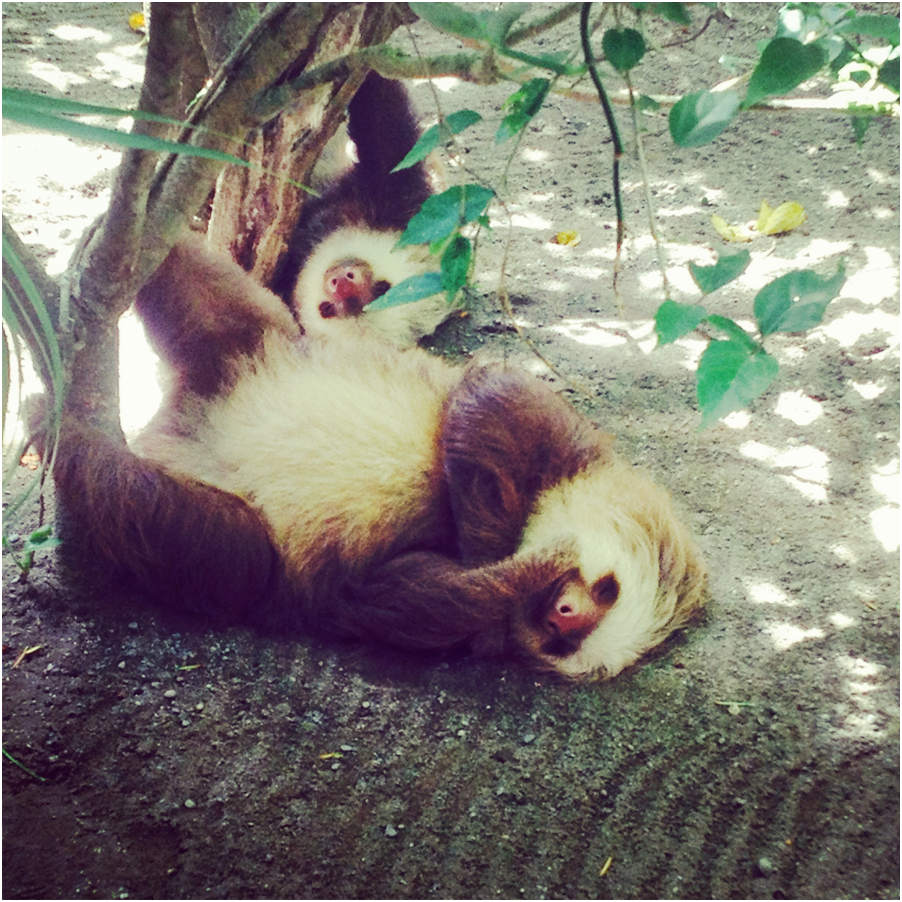 Today, Costa Rica can be considered as a model for sustainable development and ecotourism, however, Costa Rica had hit rock bottom before rising up and becoming a mecca for eco tourists and conservationists. Costa Rica was once a country that economically depended on the extraction of natural resources, but since the 1980’s its economy has shifted to the protection and conservation of its natural resources. Historically, Costa Rica, as well as the rest of Latin American nations, depended on export commodities for economic growth. Exports of coffee, wood, bananas, and beef allowed Costa Rica to enter the world market. Consequently, Costa Rican farmers deforested a majority of the land in order to produce these crops for world export. The grazing of cattle was extremely detrimental to the environment; as a result about fifty percent of the country’s forests were destroyed. During the debt crisis in the 1980’s, known as “the lost decade,” Costa Rica’s economy took off in a different direction.
Today, Costa Rica can be considered as a model for sustainable development and ecotourism, however, Costa Rica had hit rock bottom before rising up and becoming a mecca for eco tourists and conservationists. Costa Rica was once a country that economically depended on the extraction of natural resources, but since the 1980’s its economy has shifted to the protection and conservation of its natural resources. Historically, Costa Rica, as well as the rest of Latin American nations, depended on export commodities for economic growth. Exports of coffee, wood, bananas, and beef allowed Costa Rica to enter the world market. Consequently, Costa Rican farmers deforested a majority of the land in order to produce these crops for world export. The grazing of cattle was extremely detrimental to the environment; as a result about fifty percent of the country’s forests were destroyed. During the debt crisis in the 1980’s, known as “the lost decade,” Costa Rica’s economy took off in a different direction.
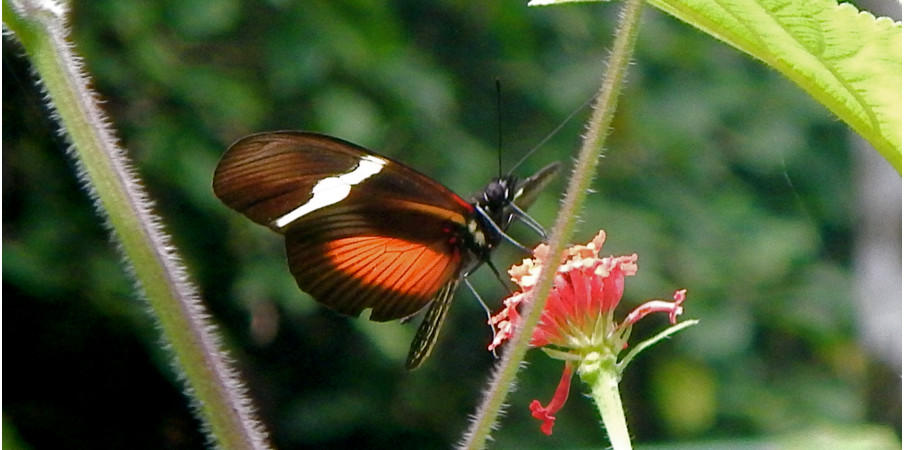 After the extreme degradation and exploitation of their land, Costa Rica had to figure out how to develop their global economy while at the same time conserve and protect the land. The answer was ecotourism. In response to the rapid deforestation rates across Costa Rica, ecotourism was developed during the 1980’s, and remains as the country’s main revenue source today. Most of the forests that remain have been preserved as national parks, reserves, and wildlife refuges and serves as tourist attractions to thousands of visitors annually. This idea of preserved forests being financially valuable compared to agricultural land, helped encourage the development of national parks and preserves. Ecotourism provides more revenue than traditional exports such as coffee, bananas, and sugar.
But it is not just the breathtaking landscapes, incredible wildlife, and beautiful fauna that attract visitors, the Costa Rican people, or Los Ticos, are amongst the main attractions. It is no wonder they are considered the happiest people in the world, they are friendly, spirited, and encompass the values of ‘Pura Vida’. They welcome foreigners into their home country with open arms and plates of comida tipica. The Ticos aim to avoid any confrontation, and they have their own consensus of time. Running on ‘Tico time’ simply means do not wear a watch. This sense of Tico Time is simply the Costa Rican way of life of enjoying every moment and living by Pura Vida.
[box title=”” border_width=”1″ border_style=”solid” align=”center”] Briana Zagami – Author for STW [/box]
After the extreme degradation and exploitation of their land, Costa Rica had to figure out how to develop their global economy while at the same time conserve and protect the land. The answer was ecotourism. In response to the rapid deforestation rates across Costa Rica, ecotourism was developed during the 1980’s, and remains as the country’s main revenue source today. Most of the forests that remain have been preserved as national parks, reserves, and wildlife refuges and serves as tourist attractions to thousands of visitors annually. This idea of preserved forests being financially valuable compared to agricultural land, helped encourage the development of national parks and preserves. Ecotourism provides more revenue than traditional exports such as coffee, bananas, and sugar.
But it is not just the breathtaking landscapes, incredible wildlife, and beautiful fauna that attract visitors, the Costa Rican people, or Los Ticos, are amongst the main attractions. It is no wonder they are considered the happiest people in the world, they are friendly, spirited, and encompass the values of ‘Pura Vida’. They welcome foreigners into their home country with open arms and plates of comida tipica. The Ticos aim to avoid any confrontation, and they have their own consensus of time. Running on ‘Tico time’ simply means do not wear a watch. This sense of Tico Time is simply the Costa Rican way of life of enjoying every moment and living by Pura Vida.
[box title=”” border_width=”1″ border_style=”solid” align=”center”] Briana Zagami – Author for STW [/box]
